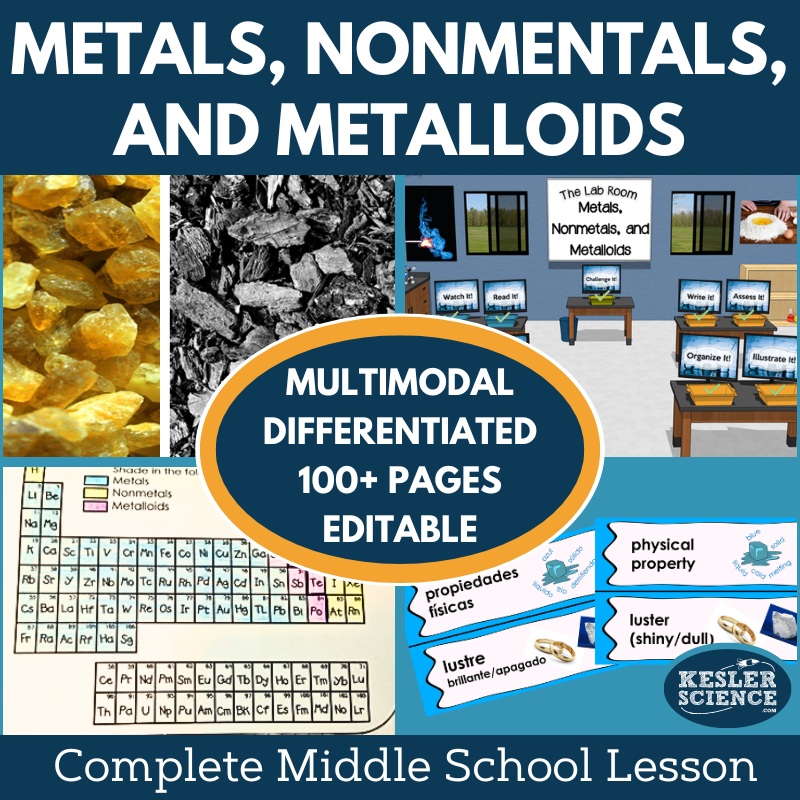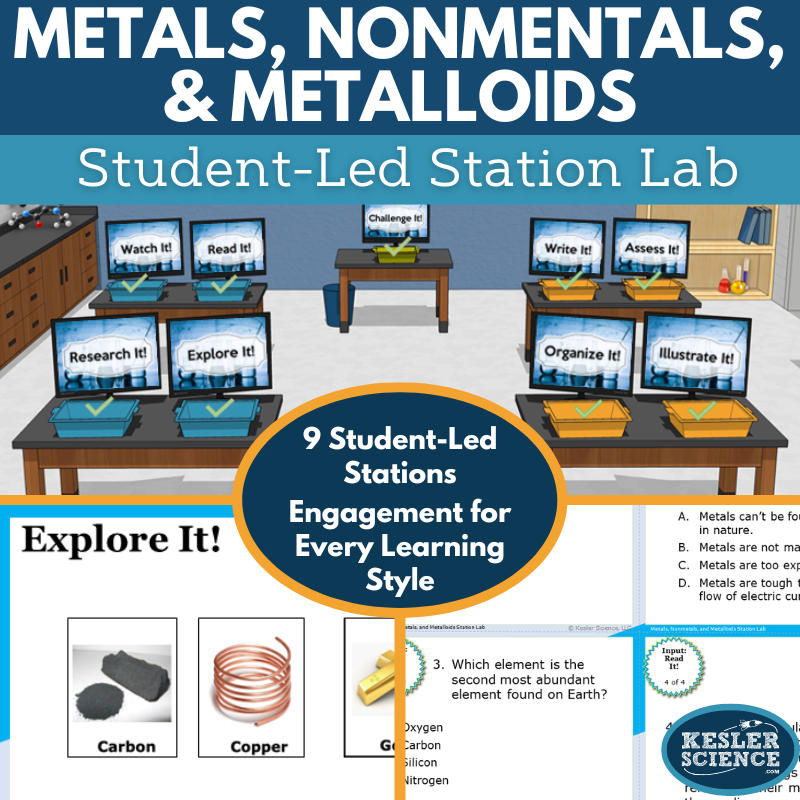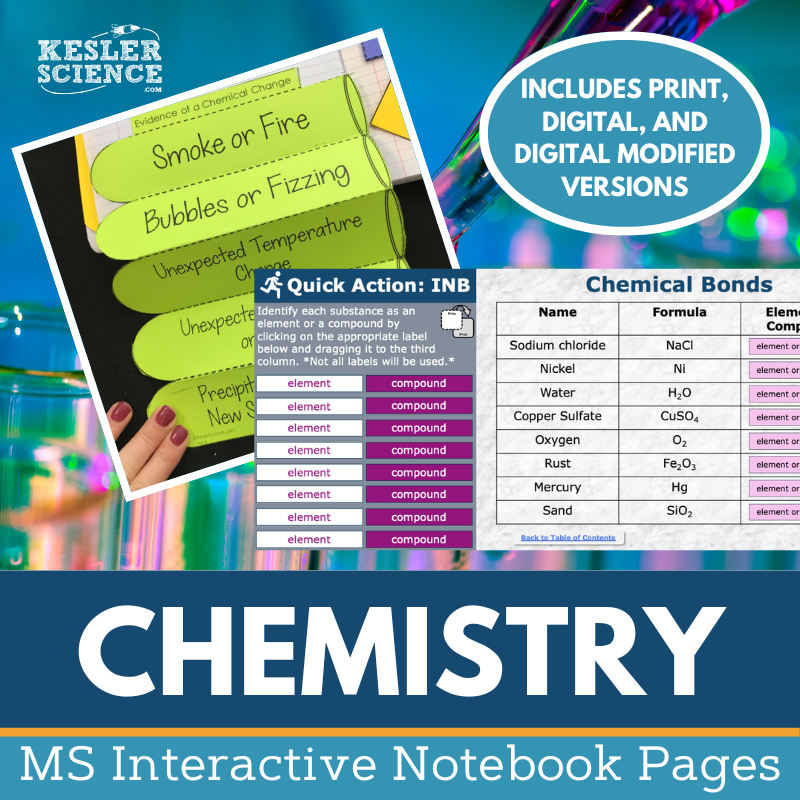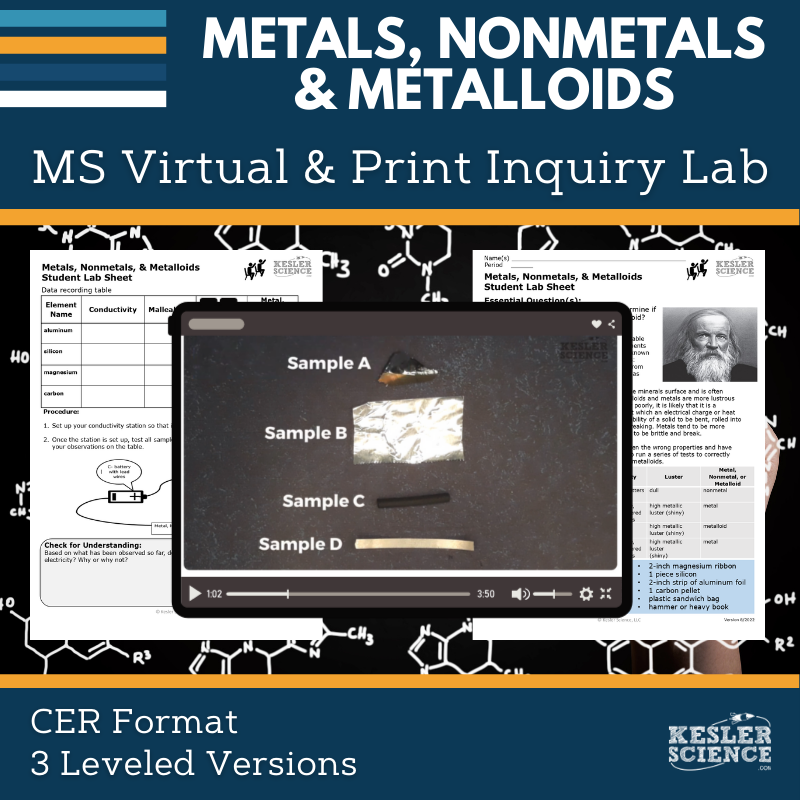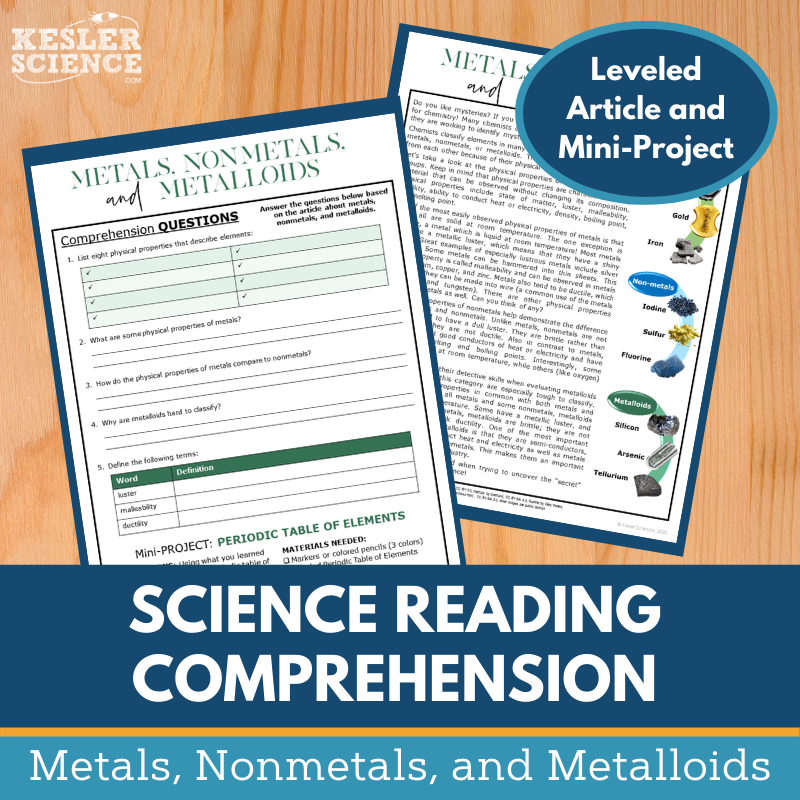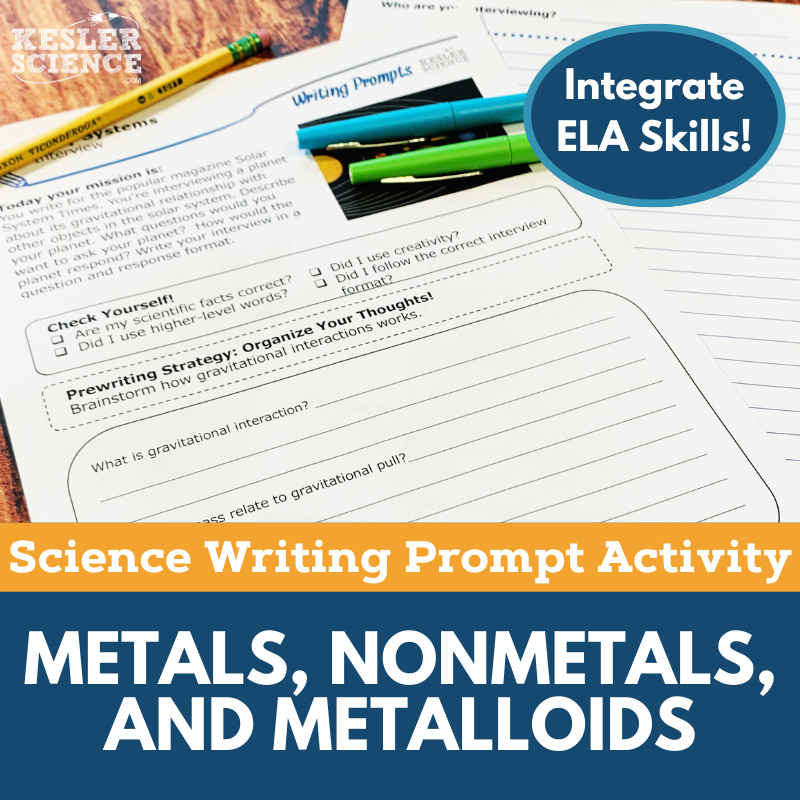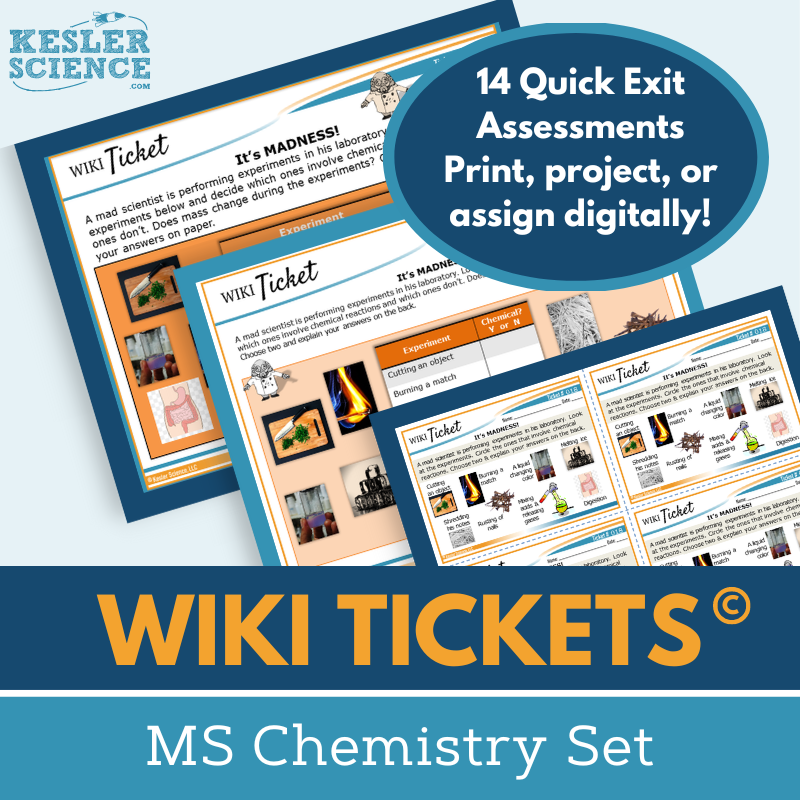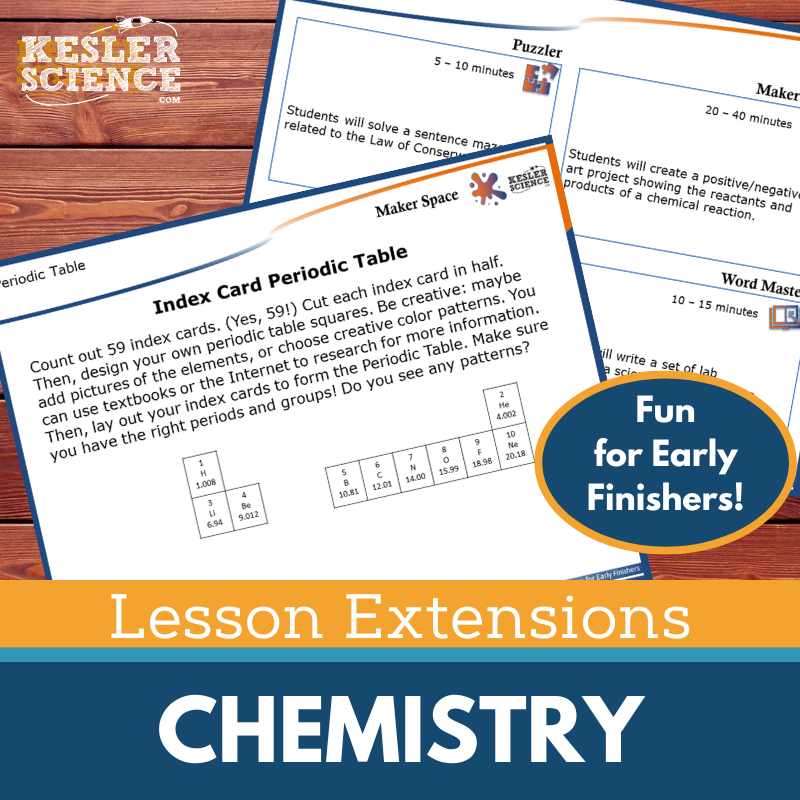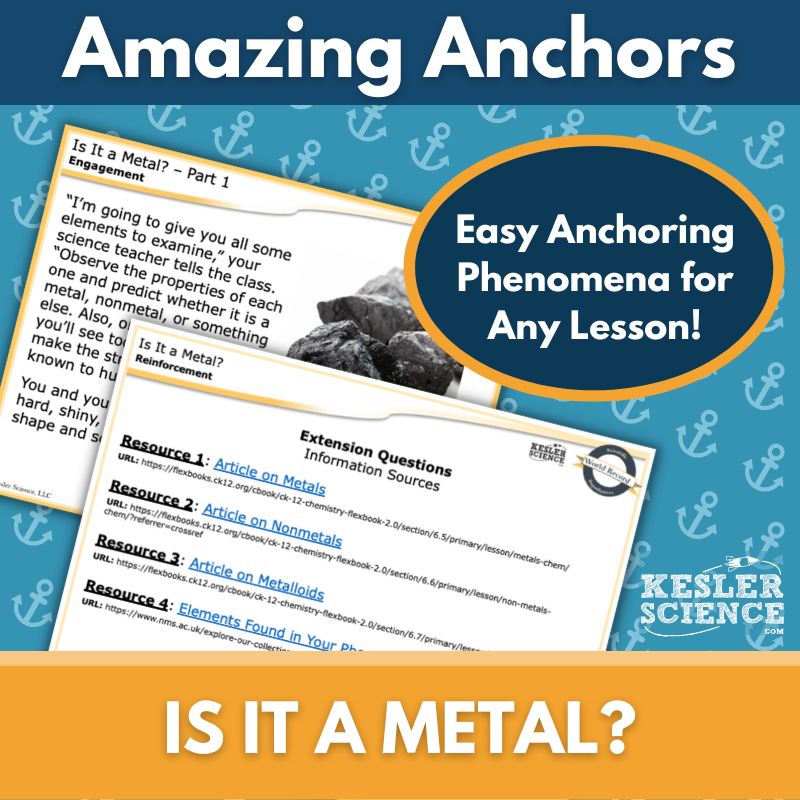Metals, Nonmetals, and Metalloids Activities for Middle School Science
The Kesler Science Metals, Nonmetals, and Metalloids resources provide a comprehensive, student-centered approach to exploring the physical properties and classification of elements. The resources below will give students a comprehensive understanding of metals, nonmetals, and metalloids. All of the following materials are also included in the Kesler Science Membership.
The Kesler Science Metals, Nonmetals, and Metalloids Complete 5E Lesson is a multi-day, student-led lesson designed for middle school students to explore and compare metals, nonmetals, and metalloids. This flexible resource offers differentiated materials for diverse learners and supports both print and digital formats, including Spanish translations for key content.
Following the 5E Model, the lesson includes engaging activities such as hands-on experiments, reading and research tasks, and video lessons to introduce key concepts. Students also complete output stations like categorization, writing, and illustrating, and can extend their learning with a bonus challenge station for advanced learners.
This lesson offers editable PowerPoints, interactive notebook templates, and various assessments, making it adaptable for in-person or virtual classrooms. Whether students are working independently or in small groups, this resource promotes deep understanding of physical properties through multimodal learning.
The Kesler Science Metals, Nonmetals, and Metalloids Complete 5E Lesson is a multi-day, student-led lesson designed for middle school students to explore and compare metals, nonmetals, and metalloids. This flexible resource offers differentiated materials for diverse learners and supports both print and digital formats, including Spanish translations for key content.
Following the 5E Model, the lesson includes engaging activities such as hands-on experiments, reading and research tasks, and video lessons to introduce key concepts. Students also complete output stations like categorization, writing, and illustrating, and can extend their learning with a bonus challenge station for advanced learners.
This lesson offers editable PowerPoints, interactive notebook templates, and various assessments, making it adaptable for in-person or virtual classrooms. Whether students are working independently or in small groups, this resource promotes deep understanding of physical properties through multimodal learning.
The Kesler Science Metals, Nonmetals, and Metalloids Station Lab is a modular, student-led activity designed to engage middle school students in comparing physical properties of metals, nonmetals, and metalloids. With eight differentiated stations, students take charge of their learning, and a challenge station is available for early finishers.
The lab includes input stations like hands-on demonstrations, research tasks, reading comprehension, and video learning. Output stations offer opportunities for students to organize, illustrate, write, and assess their knowledge through tasks, while the Challenge It! station provides additional activities for advanced learners.
This station lab is flexible for both in-person and virtual learning environments, with resources and task cards that make implementation easy and effective. Students can work independently or in small groups, and the teacher acts as a facilitator, guiding students through their personalized learning experience.
The Kesler Science Metals, Nonmetals, and Metalloids Station Lab is a modular, student-led activity designed to engage middle school students in comparing physical properties of metals, nonmetals, and metalloids. With eight differentiated stations, students take charge of their learning, and a challenge station is available for early finishers.
The lab includes input stations like hands-on demonstrations, research tasks, reading comprehension, and video learning. Output stations offer opportunities for students to organize, illustrate, write, and assess their knowledge through tasks, while the Challenge It! station provides additional activities for advanced learners.
This station lab is flexible for both in-person and virtual learning environments, with resources and task cards that make implementation easy and effective. Students can work independently or in small groups, and the teacher acts as a facilitator, guiding students through their personalized learning experience.
The Kesler Science Metals, Nonmetals, and Metalloids Student Choice Projects provide middle school students with a variety of project options to demonstrate their understanding. Students can choose from six different projects or create their own, using a grading rubric that can be customized for assessments.
This flexible resource offers nine project choices and a “design your own” option, along with teacher directions and editable rubrics to evaluate vocabulary, concepts, presentation, and accuracy. The projects cater to different learning needs, with modified versions for students needing extra support and more challenging options for advanced learners.
The Student Choice Projects require minimal supplies like paper, markers, and scissors, and many can be completed digitally. Teachers can easily adapt the activities to fit their classroom setting and student needs.
The Kesler Science Metals, Nonmetals, and Metalloids Student Choice Projects provide middle school students with a variety of project options to demonstrate their understanding. Students can choose from six different projects or create their own, using a grading rubric that can be customized for assessments.
This flexible resource offers nine project choices and a “design your own” option, along with teacher directions and editable rubrics to evaluate vocabulary, concepts, presentation, and accuracy. The projects cater to different learning needs, with modified versions for students needing extra support and more challenging options for advanced learners.
The Student Choice Projects require minimal supplies like paper, markers, and scissors, and many can be completed digitally. Teachers can easily adapt the activities to fit their classroom setting and student needs.
The Kesler Science Chemistry Interactive Notebook Bundle provides an engaging way for students to explore chemistry concepts through interactive activities. Designed for both traditional classrooms and digital learning environments, this bundle includes print and digital versions, making it versatile for in-person, 1:1, or distance learning settings.
Topics covered include acids and bases, atoms, balancing chemical equations, chemical bonds, physical and chemical changes, the periodic table, properties of water, and more. The digital version features a unique PowerPoint interactive notebook that can be uploaded to platforms like Google Slides, MS Teams, or Schoology. It includes reflection pages, note-taking space, a teacher answer key, and a modified version for students needing accommodations.
The paper version offers blank templates for student interaction, pre-filled options for modified learners or absentees, and visual examples for guidance. This resource is ideal for fostering hands-on and digital engagement in middle school chemistry.
The Kesler Science Chemistry Interactive Notebook Bundle provides an engaging way for students to explore chemistry concepts through interactive activities. Designed for both traditional classrooms and digital learning environments, this bundle includes print and digital versions, making it versatile for in-person, 1:1, or distance learning settings.
Topics covered include acids and bases, atoms, balancing chemical equations, chemical bonds, physical and chemical changes, the periodic table, properties of water, and more. The digital version features a unique PowerPoint interactive notebook that can be uploaded to platforms like Google Slides, MS Teams, or Schoology. It includes reflection pages, note-taking space, a teacher answer key, and a modified version for students needing accommodations.
The paper version offers blank templates for student interaction, pre-filled options for modified learners or absentees, and visual examples for guidance. This resource is ideal for fostering hands-on and digital engagement in middle school chemistry.
The Kesler Science Metals, Nonmetals, and Metalloids Inquiry Lab offers an interactive and flexible lab experience that allows students to engage through either digital or hands-on printed formats. Both versions include comprehension questions, Claim-Evidence-Reasoning (C.E.R.) prompts, and a reflection section to guide students through the learning process. This lab supports all learners by providing three differentiated versions—dependent, modified, and independent—so teachers can choose the appropriate level of support for their students.
In this activity, students investigate the physical properties of four elements and classify them as metals, nonmetals, or metalloids. They will use materials like a lightbulb circuit and various element samples to test properties such as conductivity and luster. The lab emphasizes student observation and critical thinking as they analyze which characteristics are most useful for identifying each group of elements.
The resource includes editable PowerPoints, Google Slides compatibility, teacher answer keys, and detailed teacher resource pages. The digital version requires no physical materials, making it ideal for absent students or tech-integrated classrooms. The print version includes all materials needed for group work, such as batteries, wires, and element samples, providing an engaging hands-on experience.
The Kesler Science Metals, Nonmetals, and Metalloids Inquiry Lab offers an interactive and flexible lab experience that allows students to engage through either digital or hands-on printed formats. Both versions include comprehension questions, Claim-Evidence-Reasoning (C.E.R.) prompts, and a reflection section to guide students through the learning process. This lab supports all learners by providing three differentiated versions—dependent, modified, and independent—so teachers can choose the appropriate level of support for their students.
In this activity, students investigate the physical properties of four elements and classify them as metals, nonmetals, or metalloids. They will use materials like a lightbulb circuit and various element samples to test properties such as conductivity and luster. The lab emphasizes student observation and critical thinking as they analyze which characteristics are most useful for identifying each group of elements.
The resource includes editable PowerPoints, Google Slides compatibility, teacher answer keys, and detailed teacher resource pages. The digital version requires no physical materials, making it ideal for absent students or tech-integrated classrooms. The print version includes all materials needed for group work, such as batteries, wires, and element samples, providing an engaging hands-on experience.
The Kesler Science Metals, Nonmetals, and Metalloids Reading Comprehension activity helps middle school students understand the physical properties of metals, nonmetals, and metalloids through a nonfiction article. After reading, students answer comprehension questions and label these elements on a periodic table, reinforcing their understanding of the topic.
Designed to increase science literacy, the resource includes two leveled articles (Lexile 1100-1300) with corresponding questions and a mini-project. The hands-on mini-project and Cornell notes template help further engage students, making the activity ideal for both in-person and virtual learning environments.
This resource is perfect for a variety of classroom settings, including remote learning through Google Classroom or other platforms. It’s great for building science reading comprehension, supporting absent students, and reinforcing key concepts through discussion and project-based learning.
The Kesler Science Metals, Nonmetals, and Metalloids Reading Comprehension activity helps middle school students understand the physical properties of metals, nonmetals, and metalloids through a nonfiction article. After reading, students answer comprehension questions and label these elements on a periodic table, reinforcing their understanding of the topic.
Designed to increase science literacy, the resource includes two leveled articles (Lexile 1100-1300) with corresponding questions and a mini-project. The hands-on mini-project and Cornell notes template help further engage students, making the activity ideal for both in-person and virtual learning environments.
This resource is perfect for a variety of classroom settings, including remote learning through Google Classroom or other platforms. It’s great for building science reading comprehension, supporting absent students, and reinforcing key concepts through discussion and project-based learning.
The Kesler Science Metals, Nonmetals, and Metalloids Science Writing Prompt Activity engages middle school students in a creative, compare-and-contrast essay that helps them explore the characteristics of metals, nonmetals, and metalloids. This activity enhances their science reasoning and writing skills, allowing them to reflect on what they've learned in a fun, student-centered format.
The resource is easy to implement, with teacher directions, rubrics, and project ideas provided for support. Students have the option of completing the activity with full-sized or half-sheet handouts, and the digital version can be assigned through Google Slides, making it flexible for both in-person and virtual learning environments.
Perfect for a variety of uses, this writing prompt works as a pre-test, extra credit, or differentiation exercise. It aligns with both TEKS and NGSS standards, making it a valuable tool for building science literacy and providing students with opportunities to deepen their understanding of the elements.
The Kesler Science Metals, Nonmetals, and Metalloids Science Writing Prompt Activity engages middle school students in a creative, compare-and-contrast essay that helps them explore the characteristics of metals, nonmetals, and metalloids. This activity enhances their science reasoning and writing skills, allowing them to reflect on what they've learned in a fun, student-centered format.
The resource is easy to implement, with teacher directions, rubrics, and project ideas provided for support. Students have the option of completing the activity with full-sized or half-sheet handouts, and the digital version can be assigned through Google Slides, making it flexible for both in-person and virtual learning environments.
Perfect for a variety of uses, this writing prompt works as a pre-test, extra credit, or differentiation exercise. It aligns with both TEKS and NGSS standards, making it a valuable tool for building science literacy and providing students with opportunities to deepen their understanding of the elements.
The Kesler Science Chemistry WIKI Tickets provide a flexible and engaging way to assess 6th-8th grade students’ understanding of key science topics. Aligned with NGSS and TEKS standards, these formative assessments are designed for both in-person and virtual learning environments. Each of the 14 topics includes multiple formats: a display version for projection, three printable handout sizes, and interactive digital files available as editable PowerPoint or Google Slides. A bonus table of contents ensures clear alignment with standards, and all topics include at least one ticket, with some offering more.
WIKI Tickets, standing for "What I Know Is," can serve as exit tickets, bellringers, or quick checks for understanding. Students can respond digitally or on paper, depending on the setting. Topics such as atomic structure, density, chemical reactions, and periodic table arrangement are covered, offering a comprehensive approach to middle school chemistry.
The Kesler Science WIKI Tickets are colorful, versatile, and designed to meet the demands of any learning scenario. Whether in a classroom or remote setting, these assessments provide a fun and meaningful way to gauge student progress while keeping them engaged.
The Kesler Science Chemistry WIKI Tickets provide a flexible and engaging way to assess 6th-8th grade students’ understanding of key science topics. Aligned with NGSS and TEKS standards, these formative assessments are designed for both in-person and virtual learning environments. Each of the 14 topics includes multiple formats: a display version for projection, three printable handout sizes, and interactive digital files available as editable PowerPoint or Google Slides. A bonus table of contents ensures clear alignment with standards, and all topics include at least one ticket, with some offering more.
WIKI Tickets, standing for "What I Know Is," can serve as exit tickets, bellringers, or quick checks for understanding. Students can respond digitally or on paper, depending on the setting. Topics such as atomic structure, density, chemical reactions, and periodic table arrangement are covered, offering a comprehensive approach to middle school chemistry.
The Kesler Science WIKI Tickets are colorful, versatile, and designed to meet the demands of any learning scenario. Whether in a classroom or remote setting, these assessments provide a fun and meaningful way to gauge student progress while keeping them engaged.
The Kesler Science Chemistry Lesson Extensions offer an engaging solution for keeping fast finishers motivated and learning. By incorporating activities that challenge critical thinking and creativity, these extensions are ideal for filling downtime during testing, curbing distractions, and wrapping up lessons. They provide rigorous yet enjoyable opportunities for students ready to delve deeper into NGSS and TEKS chemistry standards.
Each Lesson Extension includes four creative activities designed to enrich the learning experience. The "Puzzler" improves problem-solving skills through relevant puzzles, while the "Maker Space" integrates STEAM connections with hands-on projects. The "Tech Connection" allows students to demonstrate their learning through digital media, and the "Word Master" brings creative writing into the science classroom. Teachers are supported with clear directions, answer keys, and resources available in both projection and print-friendly formats.
This bundle covers essential topics such as the periodic table, chemical reactions, synthetic materials, and atomic structures. These versatile tools provide high-level supplementary materials to challenge independent learners and offer a meaningful way to conclude chemistry lessons with engagement and purpose.
The Kesler Science Chemistry Lesson Extensions offer an engaging solution for keeping fast finishers motivated and learning. By incorporating activities that challenge critical thinking and creativity, these extensions are ideal for filling downtime during testing, curbing distractions, and wrapping up lessons. They provide rigorous yet enjoyable opportunities for students ready to delve deeper into NGSS and TEKS chemistry standards.
Each Lesson Extension includes four creative activities designed to enrich the learning experience. The "Puzzler" improves problem-solving skills through relevant puzzles, while the "Maker Space" integrates STEAM connections with hands-on projects. The "Tech Connection" allows students to demonstrate their learning through digital media, and the "Word Master" brings creative writing into the science classroom. Teachers are supported with clear directions, answer keys, and resources available in both projection and print-friendly formats.
This bundle covers essential topics such as the periodic table, chemical reactions, synthetic materials, and atomic structures. These versatile tools provide high-level supplementary materials to challenge independent learners and offer a meaningful way to conclude chemistry lessons with engagement and purpose.
This Amazing Anchors Phenomenon Lesson introduces and reinforces the properties of metals, nonmetals, and metalloids through a real-world mystery metal scenario. Students begin with an engaging reading that sets the stage with comprehension and extension questions, then dive deeper into the science behind element classification with an explanatory passage and additional comprehension activities.
This TEKS-aligned, no-prep resource includes teacher directions, answer keys, and editable materials in both print and digital formats. Full-page projection slides, half- and full-sheet handouts, and Google Classroom-ready PowerPoints make it adaptable for various classroom needs. A differentiated version with sentence starters and simplified language supports diverse learners.
Designed to bookend a core lesson, this two-part resource is ideal for the Engage and Elaborate phases of the 5E model. Whether used in person or virtually, this activity helps students connect their learning to the world around them while building a deeper understanding of element properties.
This Amazing Anchors Phenomenon Lesson introduces and reinforces the properties of metals, nonmetals, and metalloids through a real-world mystery metal scenario. Students begin with an engaging reading that sets the stage with comprehension and extension questions, then dive deeper into the science behind element classification with an explanatory passage and additional comprehension activities.
This TEKS-aligned, no-prep resource includes teacher directions, answer keys, and editable materials in both print and digital formats. Full-page projection slides, half- and full-sheet handouts, and Google Classroom-ready PowerPoints make it adaptable for various classroom needs. A differentiated version with sentence starters and simplified language supports diverse learners.
Designed to bookend a core lesson, this two-part resource is ideal for the Engage and Elaborate phases of the 5E model. Whether used in person or virtually, this activity helps students connect their learning to the world around them while building a deeper understanding of element properties.
Year-Round Resources
These year-round activities will increase your students' understanding of many middle school science topics. All of these activities are also included in the Kesler Science Membership.
Visual Data & Graphing
You're not alone if your students struggle with understanding graphs, charts, and tables. It's a skill that takes an enormous amount of practice. This resource will help students build a strong foundation in analyzing data and creating their own data visualizations.
Bell Ringers and Warm-Ups
These middle school science bell ringers are an excellent way to engage your students as soon as they walk into your classroom. This comprehensive FULL YEAR resource includes everything you need to start off each science class with an interesting warm-up activity.
Review Board Games
Each game board has been carefully designed to keep students engaged. There are 10 different action spaces on each board and dozens of question cards. All of the actions are related to science concepts and keep the students motivated throughout the game.
Each game is ready to play. Simply print out the board and the cards and let the students enjoy reviewing nine different units.
Essential Questions
Below are the essential questions associated with the lessons and activities included in this unit. This topic is only one of more than 100 middle school science topics included in the Kesler Science Membership.
-
What are metals, nonmetals and metalloids?
-
How are physical properties used to compare metals, nonmetals and metalloids?
Kesler Science Membership
Imagine never having to search for another middle school science lesson again. The membership gives you access to ALL of the Kesler Science products in one place (Yes, including everything above).
Say goodbye to long hours of lesson prep.

